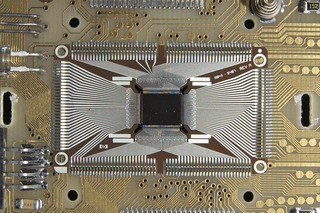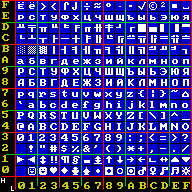The byte is a unit of digital information that most commonly consists of eight bits. Historically, the byte was the number of bits used to encode a single character of text in a computer and for this reason it is the smallest addressable unit of memory in many computer architectures. To disambiguate arbitrarily sized bytes from the common 8-bit definition, network protocol documents such as the Internet Protocol refer to an 8-bit byte as an octet. Those bits in an octet are usually counted with numbering from 0 to 7 or 7 to 0 depending on the bit endianness.

In computing and electronic systems, binary-coded decimal (BCD) is a class of binary encodings of decimal numbers where each digit is represented by a fixed number of bits, usually four or eight. Sometimes, special bit patterns are used for a sign or other indications.

Character encoding is the process of assigning numbers to graphical characters, especially the written characters of human language, allowing them to be stored, transmitted, and transformed using digital computers. The numerical values that make up a character encoding are known as "code points" and collectively comprise a "code space", a "code page", or a "character map".
In mathematics and computing, the hexadecimal numeral system is a positional numeral system that represents numbers using a radix (base) of sixteen. Unlike the decimal system representing numbers using ten symbols, hexadecimal uses sixteen distinct symbols, most often the symbols "0"–"9" to represent values 0 to 9, and "A"–"F" to represent values from ten to fifteen.
In computer science, an integer is a datum of integral data type, a data type that represents some range of mathematical integers. Integral data types may be of different sizes and may or may not be allowed to contain negative values. Integers are commonly represented in a computer as a group of binary digits (bits). The size of the grouping varies so the set of integer sizes available varies between different types of computers. Computer hardware nearly always provides a way to represent a processor register or memory address as an integer.
A computer number format is the internal representation of numeric values in digital device hardware and software, such as in programmable computers and calculators. Numerical values are stored as groupings of bits, such as bytes and words. The encoding between numerical values and bit patterns is chosen for convenience of the operation of the computer; the encoding used by the computer's instruction set generally requires conversion for external use, such as for printing and display. Different types of processors may have different internal representations of numerical values and different conventions are used for integer and real numbers. Most calculations are carried out with number formats that fit into a processor register, but some software systems allow representation of arbitrarily large numbers using multiple words of memory.
Dot-decimal notation is a presentation format for numerical data. It consists of a string of decimal numbers, using the full stop (dot) as a separation character.
4-bit computing is the use of computer architectures in which integers and other data units are 4 bits wide. 4-bit central processing unit (CPU) and arithmetic logic unit (ALU) architectures are those that are based on registers or data buses of that size. A group of four bits is also called a nibble and has 24 = 16 possible values.
An organizationally unique identifier (OUI) is a 24-bit number that uniquely identifies a vendor, manufacturer, or other organization.
A hex editor is a computer program that allows for manipulation of the fundamental binary data that constitutes a computer file. The name 'hex' comes from 'hexadecimal', a standard numerical format for representing binary data. A typical computer file occupies multiple areas on the storage medium, whose contents are combined to form the file. Hex editors that are designed to parse and edit sector data from the physical segments of floppy or hard disks are sometimes called sector editors or disk editors.
The Intel BCD opcodes are a set of six x86 instructions that operate with binary-coded decimal numbers. The radix used for the representation of numbers in the x86 processors is 2. This is called a binary numeral system. However, the x86 processors do have limited support for the decimal numeral system.
Intel hexadecimal object file format, Intel hex format or Intellec Hex is a file format that conveys binary information in ASCII text form, making it possible to store on non-binary media such as paper tape, punch cards, etc., to display on text terminals or be printed on line-oriented printers. The format is commonly used for programming microcontrollers, EPROMs, and other types of programmable logic devices and hardware emulators. In a typical application, a compiler or assembler converts a program's source code to machine code and outputs it into a object or executable file in hexadecimal format. In some applications, the Intel hex format is also used as a container format holding packets of stream data. Common file extensions used for the resulting files are .HEX or .H86. The HEX file is then read by a programmer to write the machine code into a PROM or is transferred to the target system for loading and execution. There are various tools to convert files between hexadecimal and binary format, and vice versa.
The octet is a unit of digital information in computing and telecommunications that consists of eight bits. The term is often used when the term byte might be ambiguous, as the byte has historically been used for storage units of a variety of sizes.

The Saturn family of 4-bit (datapath) microprocessors was developed by Hewlett-Packard in the 1980s first for the HP-71B handheld computer and then later for various HP calculators. It succeeded the Nut family of processors used in earlier calculators. The original Saturn chip was first used in the HP-71B hand-held BASIC-programmable computer, introduced in 1984. Later models of the family powered the popular HP 48 series of calculators. The HP48SX and HP48S were the last models to use genuine Saturn processors manufactured by HP. Later calculator models used Saturn processors manufactured by NEC. The HP 49 series initially used the Saturn CPU as well, until the NEC fab could no longer manufacture the processor for technical reasons in 2003. Therefore, starting with the HP 49g+ model in 2003, the calculators switched to a Samsung S3C2410 processor with an ARM920T core which ran an emulator of the Saturn hardware in software. In 2000, the HP 39G and HP 40G were the last calculators introduced based on the actual NEC fabricated Saturn hardware. The last calculators based on the Saturn emulator were the HP 39gs, HP 40gs and HP 50g in 2006, as well as the 2007 revision of the hp 48gII. The HP 50g, the last calculator utilizing this emulator, was discontinued in 2015 when Samsung stopped producing the ARM processor on which it was based.

Motorola S-record is a file format, created by Motorola in the mid-1970s, that conveys binary information as hex values in ASCII text form. This file format may also be known as SRECORD, SREC, S19, S28, S37. It is commonly used for programming flash memory in microcontrollers, EPROMs, EEPROMs, and other types of programmable logic devices. In a typical application, a compiler or assembler converts a program's source code to machine code and outputs it into a HEX file. The HEX file is then imported by a programmer to "burn" the machine code into non-volatile memory, or is transferred to the target system for loading and execution.
In digital computing and telecommunications, a unit of information is the capacity of some standard data storage system or communication channel, used to measure the capacities of other systems and channels. In information theory, units of information are also used to measure information contained in messages and the entropy of random variables.
Tektronix hex format and Extended Tektronix hex format / Extended Tektronix Object Format are ASCII-based hexadecimal file formats, created by Tektronix, for conveying binary information for applications like programming microcontrollers, EPROMs, and other kinds of chips.
BCD, also called alphanumeric BCD, alphameric BCD, BCD Interchange Code, or BCDIC, is a family of representations of numerals, uppercase Latin letters, and some special and control characters as six-bit character codes.
A half-carry flag is a condition flag bit in the status register of many CPU families, such as the Intel 8080, Zilog Z80, the x86, and the Atmel AVR series, among others. It indicates when a carry or borrow has been generated out of the least significant four bits of the accumulator register following the execution of an arithmetic instruction. It is primarily used in decimal (BCD) arithmetic instructions.
In computing, a hextet, or a chomp, is a sixteen-bit aggregation, or four nibbles. As a nibble typically is notated in hexadecimal format, a hextet consists of 4 hexadecimal digits. A hextet is the unofficial name for each of the 8 blocks in an IPv6 address.




